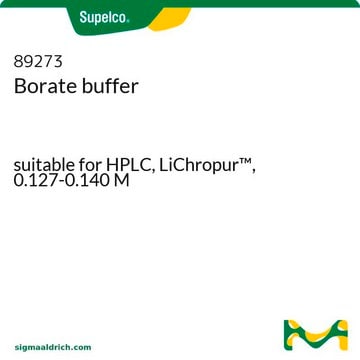S9640
Sodium tetraborate decahydrate
ACS reagent, ≥99.5%
Synonym(s):
Borax decahydrate, Sodium borate decahydrate
About This Item
Recommended Products
grade
ACS reagent
Agency
suitable for SM 4500 - NH3
vapor pressure
0.213 hPa ( 20 °C)
Assay
≥99.5%
form
powder or crystals
impurities
≤0.005% Insoluble matter
pH
9.15-9.20 (25 °C, 0.01 M in solution)
density
1.73 g/mL at 25 °C (lit.)
anion traces
chloride (Cl-): ≤0.001%
phosphate (PO43-): ≤0.001%
sulfate (SO42-): ≤0.005%
cation traces
Ca: ≤0.005%
Fe: ≤5 ppm
heavy metals (as Pb): ≤0.001%
SMILES string
O.O.O.O.O.O.O.O.O.O.[Na+].[Na+].[O-]B1Ob2ob([O-])ob(O1)o2
InChI
1S/B4O7.2Na.10H2O/c5-1-7-3-9-2(6)10-4(8-1)11-3;;;;;;;;;;;;/h;;;10*1H2/q-2;2*+1;;;;;;;;;;
InChI key
CDMADVZSLOHIFP-UHFFFAOYSA-N
Looking for similar products? Visit Product Comparison Guide
Related Categories
General description
Application
- Regioselective thiolysis of 1,2-epoxides by using thiols to synthesize β-hydroxy sulfides.
- Hetero-Michael addition of thiols with electron-deficient olefins to synthesize corresponding β-adducts.
- Solvent-free Biginelli reaction to synthesize 3,4-dihydropyrimidin-2(1H)-ones.
Legal Information
Signal Word
Danger
Hazard Statements
Precautionary Statements
Hazard Classifications
Eye Irrit. 2 - Repr. 1B
Storage Class Code
6.1D - Non-combustible acute toxic Cat.3 / toxic hazardous materials or hazardous materials causing chronic effects
WGK
WGK 1
Flash Point(F)
Not applicable
Flash Point(C)
Not applicable
Certificates of Analysis (COA)
Search for Certificates of Analysis (COA) by entering the products Lot/Batch Number. Lot and Batch Numbers can be found on a product’s label following the words ‘Lot’ or ‘Batch’.
Already Own This Product?
Find documentation for the products that you have recently purchased in the Document Library.
Customers Also Viewed
Related Content
This page is intended to make it easier to find the consumables you need based on the analytical method you’re using. Methods included on this page come from the EPA, Standard Methods and ASTM.
This page is intended to make it easier to find the consumables you need based on the analytical method you’re using. Methods included on this page come from the EPA, Standard Methods and ASTM.
This page is intended to make it easier to find the consumables you need based on the analytical method you’re using. Methods included on this page come from the EPA, Standard Methods and ASTM.
This page is intended to make it easier to find the consumables you need based on the analytical method you’re using. Methods included on this page come from the EPA, Standard Methods and ASTM.
Our team of scientists has experience in all areas of research including Life Science, Material Science, Chemical Synthesis, Chromatography, Analytical and many others.
Contact Technical Service






